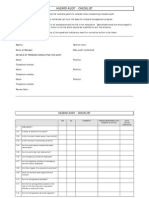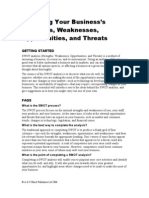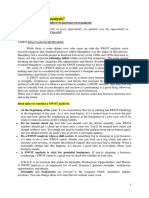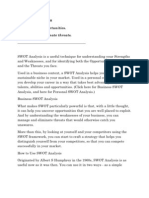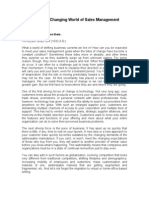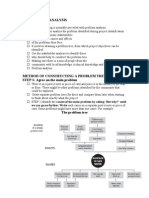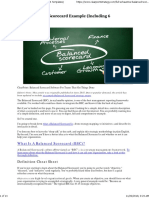0 ratings0% found this document useful (0 votes)
50 viewsShot Analysis
Shot Analysis
Uploaded by
Deep Narayan JaiswalThis document provides guidance on conducting a SWOT analysis for an organization. It explains that SWOT analysis involves identifying strengths, weaknesses, opportunities, and threats. Strengths and weaknesses are internal factors, while opportunities and threats are external. The document provides examples of questions to ask to identify each element of the SWOT analysis. It suggests starting with strengths and weaknesses since they are internal. More research may be needed to identify external opportunities and threats. Conducting a SWOT analysis can help organizations align with their goals and improve their competitive position.
Copyright:
© All Rights Reserved
Available Formats
Download as PPTX, PDF, TXT or read online from Scribd
Shot Analysis
Shot Analysis
Uploaded by
Deep Narayan Jaiswal0 ratings0% found this document useful (0 votes)
50 views7 pagesThis document provides guidance on conducting a SWOT analysis for an organization. It explains that SWOT analysis involves identifying strengths, weaknesses, opportunities, and threats. Strengths and weaknesses are internal factors, while opportunities and threats are external. The document provides examples of questions to ask to identify each element of the SWOT analysis. It suggests starting with strengths and weaknesses since they are internal. More research may be needed to identify external opportunities and threats. Conducting a SWOT analysis can help organizations align with their goals and improve their competitive position.
Original Description:
Copyright
© © All Rights Reserved
Available Formats
PPTX, PDF, TXT or read online from Scribd
Share this document
Did you find this document useful?
Is this content inappropriate?
Report this DocumentThis document provides guidance on conducting a SWOT analysis for an organization. It explains that SWOT analysis involves identifying strengths, weaknesses, opportunities, and threats. Strengths and weaknesses are internal factors, while opportunities and threats are external. The document provides examples of questions to ask to identify each element of the SWOT analysis. It suggests starting with strengths and weaknesses since they are internal. More research may be needed to identify external opportunities and threats. Conducting a SWOT analysis can help organizations align with their goals and improve their competitive position.
Copyright:
© All Rights Reserved
Available Formats
Download as PPTX, PDF, TXT or read online from Scribd
Download as pptx, pdf, or txt
0 ratings0% found this document useful (0 votes)
50 views7 pagesShot Analysis
Shot Analysis
Uploaded by
Deep Narayan JaiswalThis document provides guidance on conducting a SWOT analysis for an organization. It explains that SWOT analysis involves identifying strengths, weaknesses, opportunities, and threats. Strengths and weaknesses are internal factors, while opportunities and threats are external. The document provides examples of questions to ask to identify each element of the SWOT analysis. It suggests starting with strengths and weaknesses since they are internal. More research may be needed to identify external opportunities and threats. Conducting a SWOT analysis can help organizations align with their goals and improve their competitive position.
Copyright:
© All Rights Reserved
Available Formats
Download as PPTX, PDF, TXT or read online from Scribd
Download as pptx, pdf, or txt
You are on page 1of 7
SHOT ANALYSIS
TECHNIQUE, WHICH
OPERATES BY 'PEELING BACK
LAYERS OF THE COMPANY‘ IS
DESIGNED FOR USE IN THE
PRELIMINARY STAGES OF
DECISION-MAKING
PROCESSES
Users of a SWOT analysis often
ask and answer questions to
generate meaningful
information for each category to
make the tool useful and
identify their competitive
advantage. SWOT has been
described as the tried-and-true
tool of strategic analysis.
THE ELEMENT
OF SWOT
ANALYSIS
SWOT analyses can be applied to an
entire company or organization, or
individual projects within a single
department. Most commonly, SWOT
analyses are used at the organizational
level to determine how closely a business
is aligned with its growth trajectories and
success benchmarks
Let’s take our first element, Strengths, for example. To
determine what your strengths are as an organization,
you could begin by asking some of the following
questions:
What do your customers love about your company or
product(s)?
What does your company do better than other companies
in your industry?
What are your most positive brand attributes?
What’s your unique selling proposition?
What resources do you have at your disposal that your
competitors do not?
By answering these questions, you’ll be in great shape to
start identifying and listing your organization’s strengths.
We can use the same principle to determine your
company’s weaknesses:
What do your customers dislike about your
company or product(s)?
What problems or complaints are often
mentioned in your negative reviews?
Why do your customers cancel or churn?
What could your company do better?
What are your most negative brand attributes?
What are the biggest obstacles/challenges in your
current sales funnel?
What resources do your competitors have that
you do not?
You may find that determining the strengths and
weaknesses of your organization or project is
considerably easier or takes less time than figuring ou
the opportunities and threats facing your company.
This is because, as we said earlier, these are internal
factors. External factors, on the other hand, may
require more effort and rely upon more data, as these
are often beyond your immediate sphere of influence
Conclusion :Identifying opportunities and threats may require you to conduct in-depth competitive intelligence research about
what your competitors are up to, or the examination of wider economic or business trends that could have an impact on your
company. That’s not to say that opportunities and threats cannot be internal, however; you may discover opportunities and threats
based solely on the strengths and weaknesses of your company.
Some possible questions you could ask to identify potential opportunities might include:
How can we improve our sales/customer on boarding/customer support processes?
What kind of messaging resonates with our customers?
How can we further engage our most vocal brand advocates?
Are we allocating departmental resources effectively?
Is there budget, tools, or other resources that we’re not leveraging to full capacity?
Which advertising channels exceeded our expectations – and why?
When it comes to threats, you could certainly begin by asking a series of questions like those above. However, it’s often quite easy
to come up with a list of potential threats facing your business or project without posing questions beforehand. This could include
“branded” threats such as emerging or established competitors, broader threats such as changing regulatory environments and
market volatility, or even internal threats such as high staff turnover that could threaten or derail current growth.
Thanks
You might also like
- Design Based Research in Education Theory and Applications PhilippakosDocument349 pagesDesign Based Research in Education Theory and Applications PhilippakosFaznah MursyidiNo ratings yet
- 1967-STATISTICAL METHODS-George W.snedecor, William G.cochranDocument609 pages1967-STATISTICAL METHODS-George W.snedecor, William G.cochranmartin160464No ratings yet
- Ott Business Model For The Sports BoadcastingDocument63 pagesOtt Business Model For The Sports BoadcastingChristianNo ratings yet
- 5 Essential Steps For A Successful Strategic Marketing ProcessDocument18 pages5 Essential Steps For A Successful Strategic Marketing ProcessJack 123No ratings yet
- Safety Audit ChecklistDocument20 pagesSafety Audit ChecklistDeep Narayan Jaiswal0% (1)
- LlkUf - MBASchedule-Jan11th 2Document3 pagesLlkUf - MBASchedule-Jan11th 2Atima RDNo ratings yet
- Language Curriculum For Secondary Schools Syllabus (OBE)Document4 pagesLanguage Curriculum For Secondary Schools Syllabus (OBE)Bhenz94% (16)
- SWOT Analysis For Your Small BusinessDocument20 pagesSWOT Analysis For Your Small BusinessAlejandra Estrella MadrigalNo ratings yet
- How To Do A SWOT Analysis For Your Small Business (With Examples)Document19 pagesHow To Do A SWOT Analysis For Your Small Business (With Examples)kumarkk1969No ratings yet
- SWOT Analysis For Your Small BusinessDocument5 pagesSWOT Analysis For Your Small BusinessErnald M Du100% (1)
- SWOT ANALYSIS by Ted JacksonDocument3 pagesSWOT ANALYSIS by Ted JacksonAllan Santos Salazar100% (1)
- A Detailed SWOT Analysis Example: Four Balanced Scorecard PerspectivesDocument6 pagesA Detailed SWOT Analysis Example: Four Balanced Scorecard Perspectivesivhs aragonNo ratings yet
- SWOT) Analysis, Marketing Process, Marketing PlanDocument24 pagesSWOT) Analysis, Marketing Process, Marketing PlanSagar Patil100% (2)
- A SWOT Analysis template-BBA 140Document6 pagesA SWOT Analysis template-BBA 140Tremor BandaNo ratings yet
- A Detailed SWOT Analysis Example (Applicable To All Industries)Document9 pagesA Detailed SWOT Analysis Example (Applicable To All Industries)Aseel JameelNo ratings yet
- How To Perform SWOT AnalysisDocument12 pagesHow To Perform SWOT AnalysishoticeforuNo ratings yet
- Business Plan Swot Analysis PDFDocument5 pagesBusiness Plan Swot Analysis PDFafmbwobeh100% (1)
- Lecture On SWOT AnalysisDocument32 pagesLecture On SWOT AnalysisDasarathan Rajaraman100% (1)
- SWOT AnalysisDocument6 pagesSWOT AnalysisJPIA Scholastica DLSPNo ratings yet
- SWOT AnalysisDocument6 pagesSWOT AnalysisJPIA Scholastica DLSPNo ratings yet
- How To Do A SWOT Analysis For Better Strategic PlanningDocument4 pagesHow To Do A SWOT Analysis For Better Strategic PlanningDatuNo ratings yet
- Analyzing Your Business S Strengths Weaknesses Opportunities and ThreatsDocument4 pagesAnalyzing Your Business S Strengths Weaknesses Opportunities and ThreatsJoseph NgangahNo ratings yet
- Analyzing Your Business's Strengths, Weaknesses, Opportunities, and ThreatsDocument6 pagesAnalyzing Your Business's Strengths, Weaknesses, Opportunities, and Threatsdizzyoration3541No ratings yet
- Unit 1 - INTERNAL ANALYSISDocument29 pagesUnit 1 - INTERNAL ANALYSISaavi040389No ratings yet
- SWOT Analysis: What SWOT Stands For ConclusionDocument4 pagesSWOT Analysis: What SWOT Stands For Conclusiontinashe sibandaNo ratings yet
- SOWT Analysis EDocument6 pagesSOWT Analysis Emakarioshany997No ratings yet
- EDE2Document9 pagesEDE2YOGESH CREATION 143No ratings yet
- Swot Analysis TheoryDocument4 pagesSwot Analysis TheoryKamal TyagiNo ratings yet
- Articles Bplans Com How To Perform Swot AnalysisDocument11 pagesArticles Bplans Com How To Perform Swot AnalysisSalomón JiménezNo ratings yet
- What Is A SWOT AnalysisDocument31 pagesWhat Is A SWOT AnalysisOvidiu Sebastian ChirilaNo ratings yet
- What Is SWOT AnalysisDocument8 pagesWhat Is SWOT AnalysisJo Ann RamboyongNo ratings yet
- The SWOT Analysis Is A Valuable Step in Your Situational AnalysisDocument5 pagesThe SWOT Analysis Is A Valuable Step in Your Situational AnalysisNisa ZlkfleeNo ratings yet
- What Is A SWOT Analysis?: STRENGTHS-make A List of Your Company's Internal Strengths. These Are Any CompetitiveDocument5 pagesWhat Is A SWOT Analysis?: STRENGTHS-make A List of Your Company's Internal Strengths. These Are Any CompetitiveJoice Ann Delos SantosNo ratings yet
- Lecture 2 Aditional Reading SWOT PEST 3C's Porter Generic 5 FactorsDocument29 pagesLecture 2 Aditional Reading SWOT PEST 3C's Porter Generic 5 FactorsMacqwin FernandesNo ratings yet
- Swot AnalysisDocument21 pagesSwot AnalysisChayinne HabanNo ratings yet
- Swoc Analysis 1Document7 pagesSwoc Analysis 1Shreya PatyalNo ratings yet
- A SWOT Analysis Is A Technique Used To Determine and Define Your StrengthsDocument1 pageA SWOT Analysis Is A Technique Used To Determine and Define Your StrengthsDainelle Angelo A. LabutonNo ratings yet
- SWOT AnalysisDocument13 pagesSWOT AnalysisvicNo ratings yet
- SWOT ANALYSIS AND SELF ESTEEM (Danish Raza)Document8 pagesSWOT ANALYSIS AND SELF ESTEEM (Danish Raza)Danish RazaNo ratings yet
- SWOTDocument9 pagesSWOTdikpalakNo ratings yet
- SWOT AnalysisDocument4 pagesSWOT Analysiskly555182No ratings yet
- Lesson 1 DiscussionDocument3 pagesLesson 1 DiscussionEzard CardioNo ratings yet
- Swot Analysis Research Paper PDFDocument6 pagesSwot Analysis Research Paper PDFefgncpe8100% (1)
- SWOT Analysis Shristha BhandariDocument5 pagesSWOT Analysis Shristha Bhandarishristha bhandariNo ratings yet
- Thesis Statement For Swot AnalysisDocument4 pagesThesis Statement For Swot AnalysisWhatShouldIWriteMyPaperOnColoradoSprings100% (2)
- SWOT DraftDocument13 pagesSWOT DraftHay LinNo ratings yet
- SWOT Analysis Is Only One Stage of Business Planning: V. SWOT Analysis: Framework For Developing Marketing StrategyDocument5 pagesSWOT Analysis Is Only One Stage of Business Planning: V. SWOT Analysis: Framework For Developing Marketing StrategyLira Serrano AgagNo ratings yet
- Self Assessment: Text VersionDocument9 pagesSelf Assessment: Text VersionfischertNo ratings yet
- SWOT AnalysisDocument6 pagesSWOT AnalysisPauly LópezNo ratings yet
- Communication For Business and TradeDocument12 pagesCommunication For Business and TradeLara Kaye Ganas ValenciaNo ratings yet
- MARKETINGDocument28 pagesMARKETINGDaly DaliaNo ratings yet
- SWOT AnalysisDocument12 pagesSWOT AnalysisLalit ThakurNo ratings yet
- 5 Essential Steps For A Successful Strategic Marketing ProcessDocument26 pages5 Essential Steps For A Successful Strategic Marketing ProcessKARTHICK SNo ratings yet
- The Changing World of Sales ManagementDocument91 pagesThe Changing World of Sales ManagementNasir Ali100% (1)
- Grand Strategy: Building Your Foundation For Performance BreakthroughsDocument12 pagesGrand Strategy: Building Your Foundation For Performance BreakthroughsAnsley MaureayeNo ratings yet
- Swot AnalysisDocument13 pagesSwot AnalysisRahul BalaNo ratings yet
- Swot Business Plan TemplateDocument5 pagesSwot Business Plan Templatenhpsbyoyf100% (1)
- Develop and Implement A Business Plan: BSBMGT617Document30 pagesDevelop and Implement A Business Plan: BSBMGT617Asad AliNo ratings yet
- Write A Brief Note On SWOT AnalysisDocument2 pagesWrite A Brief Note On SWOT AnalysisSibtul Hassan100% (1)
- 5 Essential Steps For A Successful Strategic Marketing ProcessDocument26 pages5 Essential Steps For A Successful Strategic Marketing ProcessKARTHICK SNo ratings yet
- L3 Marketing ManagementDocument19 pagesL3 Marketing ManagementEman RehanNo ratings yet
- The Process of Strategic PlanningDocument4 pagesThe Process of Strategic Planningyaasir_7868868No ratings yet
- SWOT-analysis ExampleDocument3 pagesSWOT-analysis ExampleAfyq AfiziNo ratings yet
- Swot Analysis FrameworkDocument6 pagesSwot Analysis FrameworkkalyanichaurasiaNo ratings yet
- m1 SWOT-ANALYSISDocument2 pagesm1 SWOT-ANALYSISAbduirazak ZeindineNo ratings yet
- Toyota Production SystemDocument11 pagesToyota Production SystemDeep Narayan JaiswalNo ratings yet
- Presentation of 38 Seater Intercity Bus On 710 - 42 (New)Document11 pagesPresentation of 38 Seater Intercity Bus On 710 - 42 (New)Deep Narayan JaiswalNo ratings yet
- Copycat Marketing 101 PDFDocument64 pagesCopycat Marketing 101 PDFZulhaily Suaille100% (1)
- Powder Coating ProcessDocument4 pagesPowder Coating ProcessDeep Narayan JaiswalNo ratings yet
- GEMBADocument26 pagesGEMBADeep Narayan JaiswalNo ratings yet
- Hree Things in Life That, Once Gone, Never Come BackDocument2 pagesHree Things in Life That, Once Gone, Never Come BackDeep Narayan JaiswalNo ratings yet
- EN8 SteelDocument1 pageEN8 SteelDeep Narayan JaiswalNo ratings yet
- Proj Risk AnalysisDocument31 pagesProj Risk AnalysisBhawesh SthaNo ratings yet
- Harolds Stats Distributions Cheat Sheet 2022Document18 pagesHarolds Stats Distributions Cheat Sheet 2022Jack LondonNo ratings yet
- 1 Binswanger-MkhizeDocument17 pages1 Binswanger-MkhizeSauby LongangNo ratings yet
- Collegian: Michelle Barakat-Johnson, Michelle Lai, Timothy Wand, Kathryn WhiteDocument8 pagesCollegian: Michelle Barakat-Johnson, Michelle Lai, Timothy Wand, Kathryn WhiteSUCHETA DASNo ratings yet
- Cronbachs AlphaDocument2 pagesCronbachs AlphaSonia Ticona BenaventeNo ratings yet
- Chiropractic ResearchDocument3 pagesChiropractic ResearchourpatchNo ratings yet
- DSI-R - Diferenciación Del Self - MartiñoDocument13 pagesDSI-R - Diferenciación Del Self - MartiñosjulyazNo ratings yet
- Problem Analysis and LFADocument9 pagesProblem Analysis and LFAMary KishimbaNo ratings yet
- What Is A Balanced Scorecard (BSC) ?: Definition Cheat SheetDocument13 pagesWhat Is A Balanced Scorecard (BSC) ?: Definition Cheat SheetAiman Abousher100% (1)
- U TokyoDocument5 pagesU TokyoYosua Heru IrawanNo ratings yet
- Minor Projects 2023Document11 pagesMinor Projects 2023gupta00987No ratings yet
- Handout Stat Week 12 AnovaDocument7 pagesHandout Stat Week 12 AnovaIsa IrawanNo ratings yet
- Design Approaches and Tools in Education and TrainingDocument296 pagesDesign Approaches and Tools in Education and Trainingmutia febri mouliNo ratings yet
- Thera Bank PRJDocument79 pagesThera Bank PRJMandar Sonawane100% (10)
- Discussion Materials For StudentsDocument27 pagesDiscussion Materials For StudentsTobias TobiasNo ratings yet
- Palliative KnowledgeDocument6 pagesPalliative KnowledgeMahmoudNo ratings yet
- School Budgetary Needs Assessment Survey 1Document2 pagesSchool Budgetary Needs Assessment Survey 1api-557953731No ratings yet
- Assignment 8605Document16 pagesAssignment 8605Aadi AliNo ratings yet
- 2011 Guide To Holland CodeDocument5 pages2011 Guide To Holland CodeRonald OttobreNo ratings yet
- Presentation On Snowball SamplingDocument7 pagesPresentation On Snowball Samplingmandefu chanshi100% (1)
- Psychology CLASS XI-XII (2021-2022) (CODE NO. 037) (Term Wise Curriculum)Document10 pagesPsychology CLASS XI-XII (2021-2022) (CODE NO. 037) (Term Wise Curriculum)Khushi ChauhanNo ratings yet
- Environment Friendly Products Made of Bamboo For Daily Household UsageDocument43 pagesEnvironment Friendly Products Made of Bamboo For Daily Household UsageChandan SrivastavaNo ratings yet
- Chapter Four: Analysis and Interpretation: Number Percentage Sample Size 50 100 % Response Rate 50 100%Document9 pagesChapter Four: Analysis and Interpretation: Number Percentage Sample Size 50 100 % Response Rate 50 100%Mukhtaar CaseNo ratings yet
- HealthCare G11Document18 pagesHealthCare G11lakshmiNo ratings yet




